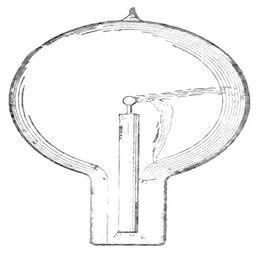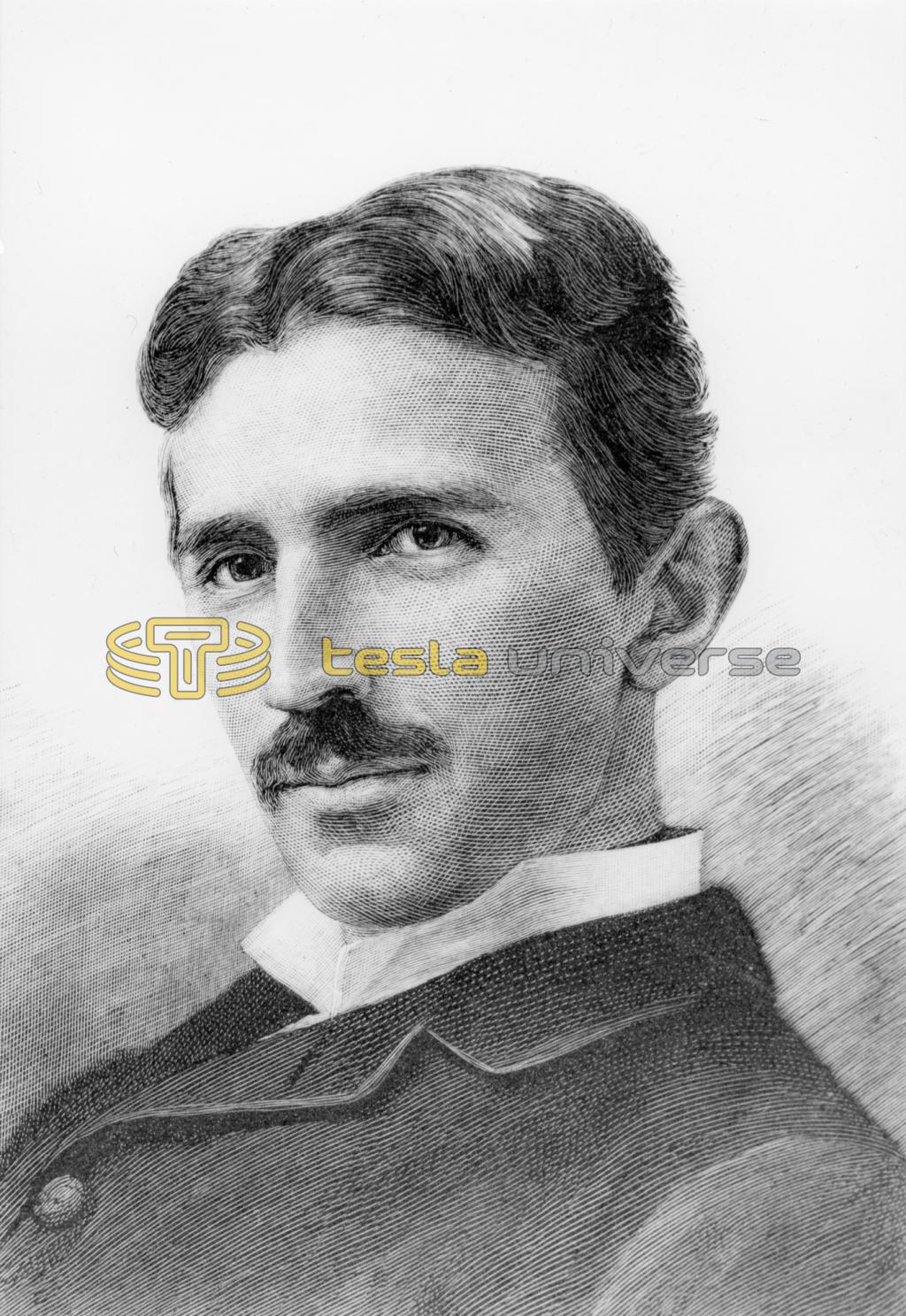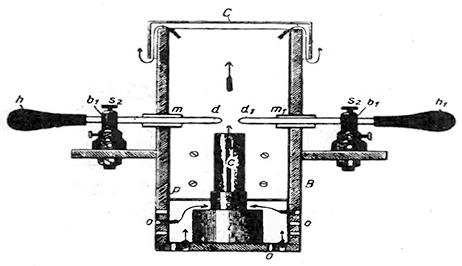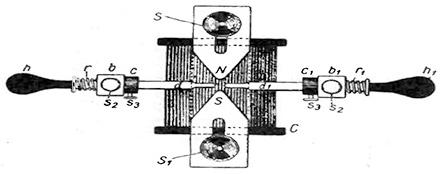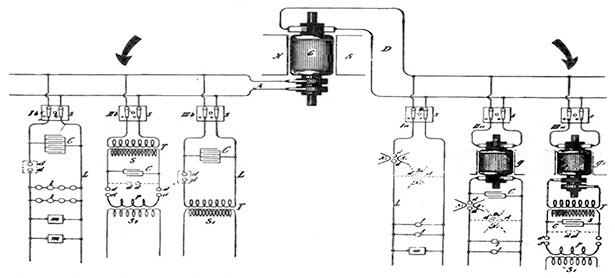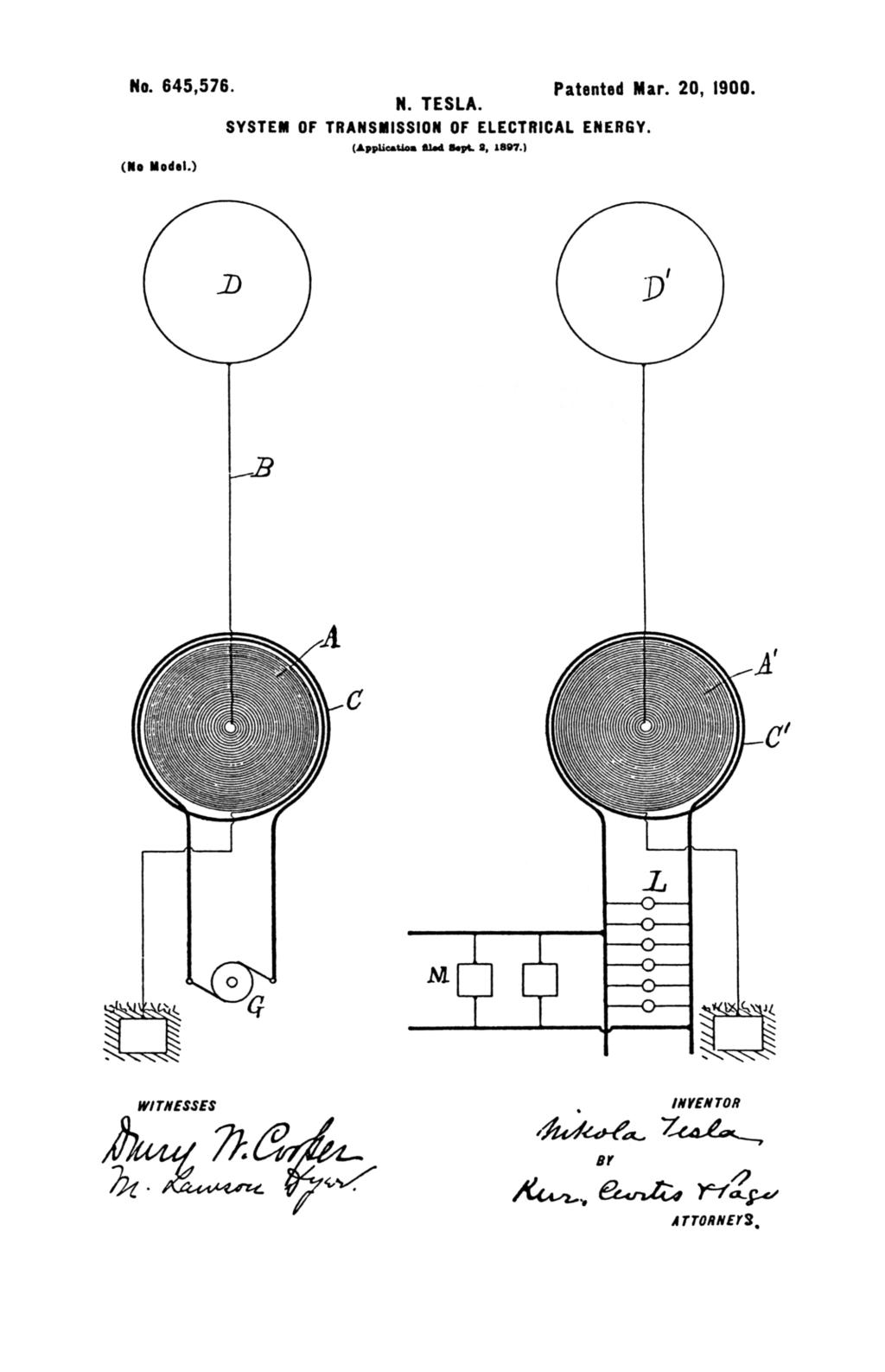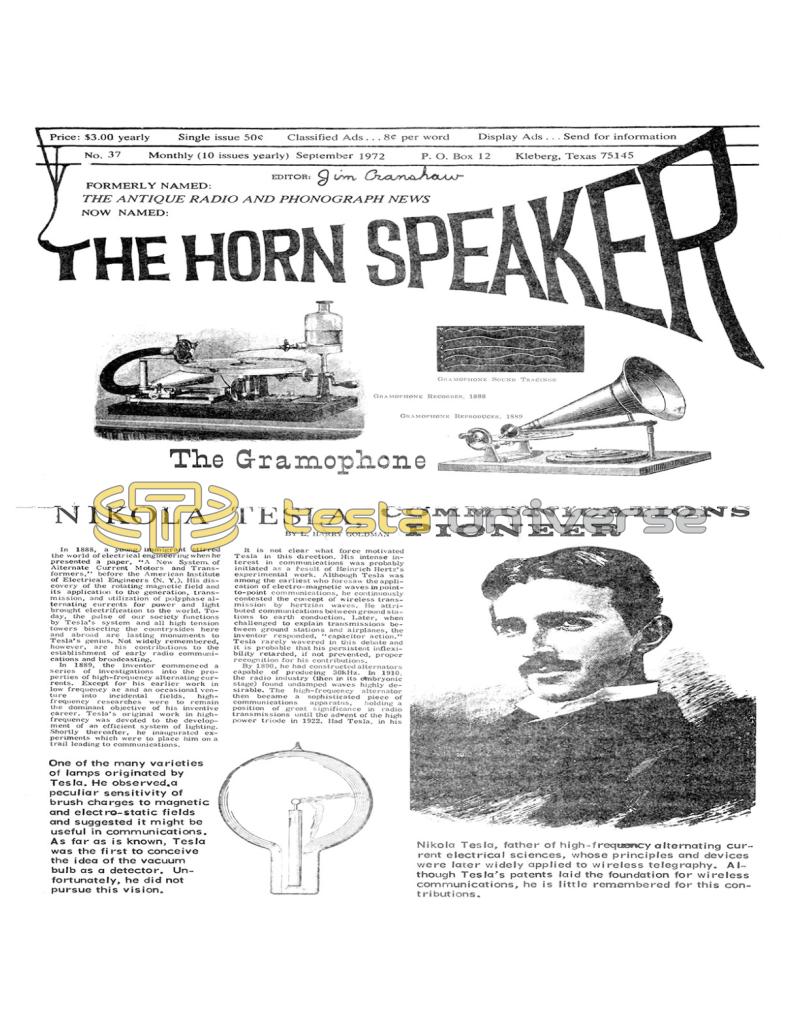
Nikola Tesla Articles
Nikola Tesla, Communications Pioneer
In 1888, a young immigrant stirred the world of electrical engineering when he presented a paper. "A New System of Alternate Current Motors and Transformers," before the American Institute of Electrical Engineers (N. Y.). His discovery of the rotating magnetic field and its application to the generation, transmission, and utilization of polyphase alternating currents for power and light brought electrification to the world. Today, the pulse of our society functions by Tesla's system and all high tension. towers bisecting the countrysides here and abroad are lasting monuments to Tesla's genius. Not widely remembered, however, are his contributions to the establishment of early radio communications and broadcasting.
In 1889, the inventor inventor commenced a series of investigations into the properties of high-frequency alternating currents. Except for his earlier work in low frequency ac and an occasional venture into incidental fields, high-frequency researches were to remain the dominant objective of his inventive career. Tesla's original work in high-frequency was devoted to the development of an efficient system of lighting. Shortly thereafter, he inaugurated experiments which were to place him on a trail leading to communications.
It is not clear what force motivated Tesla in this direction. His intense interest in communications was probably initiated as a result of Heinrich Hertz's experimental work. Although Tesla was among the earliest who foresaw the application of electro-magnetic waves in point-to-point communications, he continuously contested the concept of wireless transmission by hertzian waves. He attributed communications between ground stations to earth conduction. Later, when challenged to explain transmissions between ground stations and airplanes, the inventor responded, "capacitor action." Tesla rarely wavered in this debate and it is probable that his persistent inflexibility retarded, if not prevented, proper recognition for his contributions.
By 1890, he had constructed alternators capable of producing 30kHz. In 1910, the radio industry (then in its embryonic stage) found undamped waves highly desirable. The high-frequency alternator then became a sophisticated piece of communications apparatus, holding a position of great significance in radio transmissions until the advent of the high power triode in 1922. Had Tesla, in his original experiments, pursued the development of the high-frequency alternator to wireless communications, his conception of employing continuous waves, and his design of apparatus for producing them, would have preceded the radio industry by two decades. As a striking example of the alternator's importance in radio, it was possession of the Alexanderson alternator patents which gave RCA a decided advantage in global communications.
Tesla, again, aroused the attention of the scientific world in 1891 when he presented the first of a series of historic lectures revealing discoveries from experiments with high-frequency alternating currents. (1) Among these was the disclosure of a new kind of transformer. Better known then as a "Tesla" coil, this device later became the heart of all significant communications systems as the all-important oscillation transformer. Consequently, Tesla, in his early experiments, stumbled upon another important facet to communications - inductively coupled-tuned circuits. Time has not dimmed their importance.
One can gain an insight into the inventor's experimental wisdom and prophetic vision in the reading of his 1892 lecture before the Institution of Electrical Engineers of London. Referring to a sensitive brush discharge in one of his vacuum tubes, Tesla describes its sensitivity to magnetic and electrostatic influences and states, "I think that it may find practical application in (wireless) telegraphy. With such a brush, it would be possible to send dispatches across the Atlantic, for instance, with any speed... (2) Although the Edison effect phenomenon in incandescent vacuum bulbs, later to become the basis for the radio tube, was well known, I know of no reference prior to Tesla's suggestion that the vacuum tube be utilized as a component in communications. Historians, it seems, have missed the import of Tesla's declaration for I have read no publication which credits Tesla with the conception of using a vacuum tube as a detector.
The present-day state of technology may serve to blind us from sensing the impact of Tesla's predictions. After all, the ease with which we can communicate with the moon astronauts (Tesla was one of the earliest, if not the first, to predict interplanetary communications) tends to portray those pioneers communications early in as a bunch of tinkerers. But at that time, they were crossing a frontier beyond which no one had leaped and the other side appeared quite hazy. Leading figures in the scientific world publicly conceded the impossibility of traversing the Atlantic's prohibiting span with an electromagnetic wave. To Tesla, the earth's magnitude was of little significance. "I would say a few words on a subject which constantly fills my thoughts and which concerns the welfare of all. I mean the transmission of intelligible signals or perhaps even power to any distance without the use of wires. We need not be frightened by the idea of distance. To the weary wanderer counting the mileposts, the earth appear very large; but to the happiest of all men, the astronomer, who gazes at the heavens, and by their standards judge the magnitude of our globe, it appears very small. And so I think it must seem to the electrician... it certainly is possible...to produce some electrical disturbance sufficiently powerful to be perceptible by suitable instruments at any point of the earth's surface." (3)
In his final lecture of the "trio-series'', Tesla suggested a system of radio communications employing synchronized aerial-ground elements at the transmitting and receiving station. (4) In view of this disclosure, it would seem that he was the first to conceive the idea of using transmitting and receiving antennae tuned to the same frequency. Therefore, by 1893, some four years before contemporaries had made equally significant contributions to the art, it appeared that Tesla possessed both the technology and ambition necessary for bringing radio communications to its fruition. What, then, barred him from achieving the honor?
On March 13, 1895, the entire contents of his inventive career, as well as records, documents, and a world's fair exhibit were lost when a fire destroyed his New York City laboratory. Incredible as it may seem, in less than two years following this tragedy, Tesla had carried out investigations in the field of x-ray, studies of the dynamics of mechanical vibrations, the invention of electromechanical isosynchronous alternating current generators, as well as experiments with radio-controlled devices. One of his most important contributions of this period was a patent containing the fundamental principle upon which the "four-tuned-circuit" system system of radio transmission was to be founded. (5) Professor Adolph Slaby, German's leading authority in early communications, demonstrated an enthusiastic appreciation for Tesla's work. In declaring Tesla as the "Father of Wireless," he wrote, "I have been engaged for some time in investigations in telegraphy without wires, which you have first announced in your 'Inventions. It will interest you as the father of this telegraphy.....''(6)
Restricted by the limits of his New York laboratory, Tesla left for Colorado Springs in 1899 to initiate experiments on a large scale. Communications was to be but one phase of his project. Another was the transmission of electricity without the use of power lines. He was of the conviction that resonant efforts of large magnitude would enable him to utilize the earth as as a conductor. "Not only was it practicable to send telegraphic messages to any distance without wires," stated Tesla, "...but also to impress upon the entire globe the faint modulations of the human voice, far more still, to transmit power, in unlimited amounts to any terrestrial distance and almost without loss." (7)
There, on the plains below Pike's Peak, he constructed a large barn-like laboratory containing an array of apparatus reminiscent of a Jules Verne fantasy. The concrete achievements of the Colorado adventure remain obscure. Except for a lecture, some scattered notes, and a few ambiguous articles, he never fully disclosed the outcome of the experiment. He announced the discovery of standing waves induced in the earth's static charge by nature's lightning and was able to duplicate them by bringing about an immense resonant action. In an experiment which has not since been equaled, Tesla produced an absolute potential of 18 million volts and antenna currents of 1,110 amperes.
Tesla demonstrated the vision of a true prophet when he suggested the employment of standing waves as a means for detecting the position and movement of distant objects. "...by their use... we may determine the relative position or course of a moving object such as a vessel at sea..."(8) Once again, Tesla chose not to pursue a promising vision but left to others the development of radar.
Tesla returned to New York in 1900 and began construction of a transmitting plant on Long Island. Residents of early Shoreham can recall the gigantic tower situated on a tract of land known as Wardenclyffe. The station was to be but one of a series of components making up Tesla's World System" of broadcasting. In addition to the distribution of news, music, and humanity services provided by today's communications media, the inventor promised a number of startling benefits. It was to establish a universal system of telephone, telegraph, and stock ticker services; a precision clock system whereby all the world's timepieces would be accurately synchronized from a master station, a safe system of navigation enabling control of direction without the need of compasses and an ability to determine the exact location, hour, and speed at a moment's notice. In addition, it was to provide a world system of private telephone communications between parties, regardless of distance, with an incredible device small enough to be carried on one's pocket.
The Long Island plant was never completed. The cost of the project exceeded the inventor's available funds and creditors refused further investments when rumors circulated debasing the scheme as a fairy tale.
In an objective which no other person had then dreamed possible, Tesla had visualized, and nearly created, broadcasting some twenty years preceding its eventuality. Edwin H. Armstrong, radio pioneer and inventor of FM, paid great tribute to Tesla's prophetic vision of broadcasting when he stated, ". . . the instrumentalities for practicing broadcasting were not then in existence. Tesla was classed as a visionary and his prophecy was forgotten. What harsher terms might, with justice, be applied to many of us who helped produce the instrumentalities with which broadcasting was eventually accomplished. We applied them to point-to-point communications, failing completely to realize the significance of Tesla's words." (9)
In addition to the major goals mentioned herein, Tesla made an infinite variety of contributions to communications that remain generally unheralded. The most striking example is a patent describing an invention for controlling moving objects by radio waves. (10) With this invention, Tesla singularly ushered in the age of radio-guidance systems. "We shall be able... to send a projectile at a much greater distance; it will not be limited in any way, weight, or amount of explosive charge; we shall be able to submerge it at command, to arrest it in its flight and call it back, and to send it out again and explode it at will; and more than this, it will never make a miss. . ."(11) A vital part of Tesla's system of radio-control was a patent which provided for multi-channel non-interferable radio transmission. (12) This, and his "four-tuned" circuit patent are, perhaps, the two most significant contributions forming the foundation for the radio art.
The science world did not stand idly by while Tesla spewed forth his prophecies and visions. It considered his guided-missle theories incredible and was quick make its viewpoints known. Although spectacular demonstrations of his radio-controlled devices were presented in a week-long display in New York City, and later, in Chicago, colleagues refused to concede the possibility of Tesla's missle. Said one reporter, "We have recently been informed by the public press in flamboyant rhetoric that Nikola Tesla has devised a boat which is destined to revolutionize warfare. Mr. Tesla's improvement has been introduced to the world with some of the most extravagant rhapsodies that ever threw discredit upon an untried inventor.
"It could strike, we are told, a vessel that lay in Southampton, England, while the operator was snugly ensconced in the forts at Sandy Hook. What possible good can be done either to the inventor himself or to the great cause of science... by confusing the minds of the public by such unscientific exaggerations as we have quoted above?" (13)
Others were even less optimistic, "When we are expected to accept in silence such an utterance as quoted above...we refuse point blank, and we are willing to face the consequences." (14)
This form of opposition did not deter Tesla from expanding on his vision for, to him, this was but the beginning. In a gesture typical of his unlimited imaginative powers, he proposed radio-controlled robots capable of thinking for themselves. He coined them AUTOMATONS. "...it will be able to follow a course laid out or to obey orders given far in advance; it will be capable of distinguishing between what it ought and what it ought not to do..."(15) Tesla's utterances raised more than the eyebrow of the scientific world. Resulting protests surpassed the discontent of indignation. The significance of Tesla's words, however, becomes more apparent when we consider today's vast arsenal of guided missiles and self-thinking machines. The fact that we can send a missile, manned or unmanned, to the moon, that it will know where it ought to land or ought not to land, that it will return to earth on a pin point landing, all without human interference, is evidence of performance exactly as Tesla predicted.
Among his incidental contributions to radio communications was the Tesla "ticker", a device for making continuous waves audible. This apparatus was a vital part of the Poulsen Arc stations until the heterodyne beat-note system was introduced to radio engineering. Several forms of Tesla's high-frequency spark apparatus were utilized by early transmitting stations for many years. His radio patents advanced the quarter-wave principle as well as antennas in the form of a loop. And it was Tesla who pointed out the importance of oil as an insulating medium in high voltage equipment and who suggested the use of insulated stranded wire, later called Litzendraht, in high-frequency circuits.
Considering all that has been mentioned in the foregoing, why then is the name Nikola Tesla not listed among the journals of radio engineering history? Several explanations are possible. For one, Tesla was a complex personality. Hampered by a grand gesture personality and driven by an extra-ordinary ingenuity, his talents remained eternally subservient to a passionate and inexorable urge for crossing frontiers while leaving for others the benefits of commercial development. Secondly, Tesla was forever being diverted off on tangents away from the path of his major goals, delaying, if not preventing, final achievements of his original destinations.
In addition, Tesla's extremes of individuality may have been his greatest failing. Without detracting from their brilliant work, it is known that the many successes of men such as Edison resulted from an ability to attract the assistance of highly capable associates. Tesla, however, was unable by temperament to avail himself of this advantage. Lee De Forest, an inventor whose contributions are well established in the glorious history of radio, pleaded to be taken in as a Tesla assistant. Undoubtedly, other talented personalities would have been more than happy to join the Tesla camp. Unfortunately, Tesla was a born "loner" who stood aloof and out of reach of those with whom he mingled.
On December 12, 1901, while Tesla was constructing his 300,000-watt Long Island broadcasting station, Guglielmo Marconi, with but a fraction of that power, scooped the scientific world by sending three dots across the Atlantic from England to Newfoundland. The scientific society hailed Marconi. Tesla sent a congratulatory note but it was quite evident that he had been struck a blow by Marconi's feat. A crushing defeat, and perhaps the most important deterrent, to Tesla's bid for radio immortality came about in 1915 when he battled Marconi over the fundamental issues upon which early radio had become established. The courts ruled against Tesla, a judgement which was to provide Marconi the means for instituting unmitigated assertions for the invention of wireless.
Be all that as it may, Tesla's part in the evolution of communications was not to be denied completely. In 1943 (the year of Tesla's death), long after the radio empire had been well established, the U. S. Supreme Court declared the Marconi "four-tuned-circuit" patent (his most important contribution) invalid due to prior disclosure by Tesla. (16)
In summation, we find in Nikola Tesla a personality possessing an experimental acuity and prophetic vision equaled by no more than a handful of colleagues and surpassed by none. In an evaluation of the inventor's contributions to radio engineering, L. P. Wheeler credits Tesla with the independent discovery of the principle of inductive coupling between the driving and working circuits, the importance of tuning both circuits (oscillation transformer), and the employment of the open secondary circuit. He describes Tesla as "...an immensely energetic personality possessing great skill in ac techniques and great ingenuity in their utilization... his earlier accomplishments... together with the inspiration given to many through his public lectures, would seem to justify a place in the history of radio engineering not so very far below that due to his accomplishment in the field of low-frequency alternating currents. (17)
REFERENCES CITED.....
(1) Nikola Tesla, "Experiments with Alternate Currents of Very High Frequency and Their Application to Methods of Artificial Illumination." A lecture before the American Institute of Electrical Engineers, N. Y. May 20, 1891.
(2) Nikola Tesla, "Experiments with Alternate Currents of High Frequency." A lecture before the Institute of Electrical Engineers, London, February, 1892.
(3) Nikola Tesla, "On Light and Other High Frequency Phenomena," A lecture before the Franklin Institute, Philadelphia, February, 1893, and before the Electric Light Association, March, 1893. St. Louis,
(4) Ibed.
(5) Nikola Tesla, patent #645,576, applied for September 2, 1897 and allowed March 30, 1900.
(6) Professor Adolph Slaby, in a letter to Tesla, Dec. 1, 1898, (original in Nikola Tesla Museum, Beograd, Yugoslavia).
(7) Nikola Tesla, "The Transmission Electrical Energy Without Wires," "The Electrical World and Engineer," March 5, 1904.
(8) Nikola Tesla, "The Problem of Increasing Human Energy," The Century Magazine, June 1900,
(9) Edwin H. Armstrong, "Tribute To Tesla," Scientific Monthly, April, 1943.
(10) Nikola Tesla, patent #613,809, application July 1, 1898, allowed November 8, 1898.
(11) Nikola Tesla, "Nikola Tesla and His Work," New York Sun, November 21, 1898.
(12) Nikola Tesla, patent #723,188, application filed June 14, 1901 and allowed March 17, 1903.
(13) Editorial, "Scientific American," November 19, 1898.
(14) Editorial, Electrical Engineer", November, 1898.
(15) Nikola Tesla, "The Problem of Increasing Human Energy," "Century Magazine. June, 1900.
(16) "United States Reports", "Marconi Wireless Telegraph Co. vs. United States," Volume 320, October terms 1942/43.
(17) L. P. Wheeler. "Tesla's Contribution To High Frequency", Electrical Engineering (N. Y.), August 1943.
RECOMMENDED READING.....
(3) T. C. Martin, "Inventions, Researches, and Writings of Nikola Tesla, Electrical Engineer, N. Y., 1894 (Reproduced by Lee Engineering Company, Milwaukee, Wisconsin, 1952.
(2) "Nikola Tesla, Lectures, Patents, Articles, Nikola Tesla Museum, Beograd, Yugoslavia, 1956.
(3) Tribute To Nikola Tesla, Letters, Articles, Documents," Nikola Tesla Museum , Beograd, Yugoslavia, 1961.
